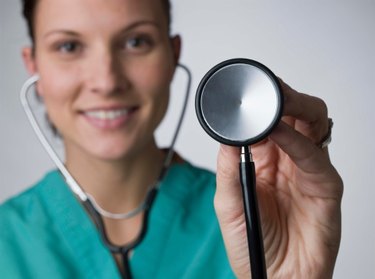
Cardiovascular System
An understanding of how the respiratory and cardiovascular systems interact requires knowledge of how each of the systems function independently. The cardiovascular system in the human body is made up of the heart and blood vessels, which are divided into arteries, veins and capillaries. The heart is responsible for pumping the blood throughout the blood vessels and is divided into four chambers, two of which are responsible for moving poorly oxygenated blood and two of which move highly oxygenated blood. Oxygenated blood, which is pumped through the body via the arteries, supplies the body's tissues with oxygen that they need to live. Blood in the arteries is under high pressure; however, which could damage the tissue, so this oxygenated blood first needs to go to the capillaries, which are very small and low-pressure blood vessels that are responsible for supplying the oxygenated blood to the tissues. Once the capillaries have delivered their oxygen, they also absorb excess carbon dioxide into the blood and then deliver it to the veins, which then supply the blood back to the heart.
Respiratory System
Video of the Day
The respiratory system system is primarily comprised of the airways, the lungs and the structures (such as muscles) that help move air in and out of the lungs. The airway, which begins with the nose and mouth, continues down through the throat into the bronchi, which are small airways that eventually feed into the lungs, which are lined with cells called alveoli. The other part of the respiratory system is the muscles, such as the intercostals (muscles between the ribs) and the diaphragm, which cause the lungs to expand and contract. When the size of the lungs changes, so does the pressure inside, leading to air either coming in (inhalation) or being forced out (exhalation).
Video of the Day
Interaction
The cardiovascular and the respiratory system both work toward the same goal: getting oxygen to tissues and getting carbon dioxide out. The respiratory system is involved in supplying oxygen to the blood and removing carbon dioxide. When the heart receives blood that is low in oxygen and high in carbon dioxide, it pumps it to the lungs via the pulmonary arteries. When the lungs expand and get fresh air from the environment, oxygen is transferred (via the alveoli) into the low-oxygen blood, which also then sends some of its carbon dioxide back into the lungs. Now that this blood has fresh oxygen in it, it returns to the heart and the heart then pumps it throughout the body.
Is this an emergency? If you are experiencing serious medical symptoms, please see the National Library of Medicine’s list of signs you need emergency medical attention or call 911.